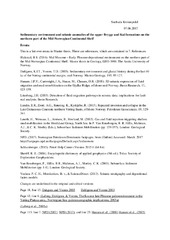| dc.contributor.advisor | Laberg, Jan Sverre | |
| dc.contributor.advisor | Rydningen, Tom Arne | |
| dc.contributor.advisor | Rafaelsen, Bjarne | |
| dc.contributor.author | Krokmyrdal, Suchada Yaiying | |
| dc.date.accessioned | 2017-06-09T11:05:51Z | |
| dc.date.available | 2017-06-09T11:05:51Z | |
| dc.date.issued | 2017-05-15 | |
| dc.description.abstract | The sedimentary environment and seismic anomalies of the upper Brygge and Kai formations on the northern part of the Mid-Norwegian Continental Shelf is analysed from 3D seismic data and the exploration well 6604/2-1. This was done in order to give a better understanding of the paleo-climatic development in the period before the establishment of the large-scale ice sheets of the Northern Hemisphere, and to provides a better insight in the relationship to fluid and/or gas migration from different levels in the subsurface. Based on a seismic stratigraphic analysis, correlation to well logs and previous work in the area, five seismic sub-units were recognized: B1-B2 of the upper Brygge Formation (pre-mid Miocene), and K1-K3 of the Kai Formation (mid Miocene-early Pliocene). The geometry and internal seismic reflection facies, as well as the morphology of buried surfaces have been described and discussed in relation to the depositional environment and the development of the ocean circulation pattern in the Norwegian Sea.
Based on the seismic analysis, a signature characteristic of contourite deposits was identified in the study area. Mounded elongated contourite drifts formed by ocean current-controlled deposition was observed in the upper Brygge Formation. After a period of tectonic uplift in the mid-Miocene, local anticlinal highs were developed, including the Helland-Hansen and Modgunn arches. These features probably played a major role in controlling the flow pattern of the ocean currents, associated with the deposition of the Kai Formation sediments. The ocean currents were entering the study area from the south, resulting in erosion in the southern part and deposition in the northern part. During the late Miocene-early Pliocene time, a change of the ocean current pattern led to erosion in the northern part, and deposition in the southeastern part of the study area.
Seismic attribute analysis revealed seismic anomalies, including circular forms. These are classified into three types, based on their stratigraphic distribution and dimensions, and association with fluid and/or gas migration from deep to shallow strata. The cluster of high amplitude anomalies, including bright spots and acoustic pipes indicate fluid flow originating from deep stratigraphic levels to terminate at or near the top of the Kai Formation. Paleo-pockmarks resulted from fluid migration along major faults from a deep thermogenic source, and eventually fluid expulsion from the polygonal fault system. | en_US |
| dc.identifier.uri | https://hdl.handle.net/10037/11132 | |
| dc.language.iso | eng | en_US |
| dc.publisher | UiT Norges arktiske universitet | en_US |
| dc.publisher | UiT The Arctic University of Norway | en_US |
| dc.rights.accessRights | openAccess | en_US |
| dc.rights.holder | Copyright 2017 The Author(s) | |
| dc.rights.uri | https://creativecommons.org/licenses/by-nc-sa/3.0 | en_US |
| dc.rights | Attribution-NonCommercial-ShareAlike 3.0 Unported (CC BY-NC-SA 3.0) | en_US |
| dc.subject.courseID | GEO-3900 | |
| dc.subject | VDP::Matematikk og Naturvitenskap: 400::Geofag: 450::Marin geologi: 466 | en_US |
| dc.subject | VDP::Mathematics and natural science: 400::Geosciences: 450::Marine geology: 466 | en_US |
| dc.title | Sedimentary environment and seismic anomalies of the upper Brygge and Kai formations on the northern part of the Mid-Norwegian Continental Shelf | en_US |
| dc.type | Master thesis | en_US |
| dc.type | Mastergradsoppgave | en_US |


 English
English norsk
norsk

